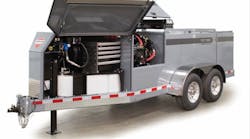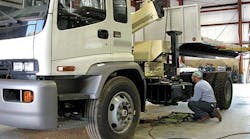National Truck Equipment Association (NTEA) technical services manager Steve Spata says a question regularly emanates from industry companies: “What is certification? We hear that term a lot, but what does it really mean?”
He said it is a company’s representation that a vehicle it manufactures meets all applicable Federal Motor Vehicle Safety Standards (FMVSS). It’s that representation that a company is putting together a compliant vehicle.
“Labeling is actually the last step in the certification process,” Spata said. “It’s the most visual one. It’s the step a lot of people associate with certification, but it’s really a broader process than just that. The label is more of a symbol of everything that goes behind it—weight distribution, a review of the Incomplete Vehicle Document (IVD) and body builder information, compliance analysis and documentation, and requesting compliance representations from equipment/system suppliers.
“You have components and systems that you end up installing to put vehicles together, and companies you get those from often have information for you as someone certifying the vehicle to draw upon, and you rely on some of the rationale they might be able to provide. Always take advantage of that with the things you get from suppliers—axles, lighting, things that affect different standards. Always try to get that information for your own records.”
In a webinar, “Understanding Multi-Stage Vehicle Certification Labels,” Spata said certification is required for all vehicles under Title 49 US Code §30112 (Prohibitions on Manufacturing, Selling and Importing Noncomplying Motor Vehicles and Equipment).
Certification comes from a manufacturer, which, according to the Motor Vehicle Safety Act, is someone manufacturing or assembling motor vehicles or motor vehicle equipment; or importing motor vehicles or motor vehicle equipment for resale.
Manufacturers must provide identifying information with NHTSA as required by 49 CFR Part 566—Manufacturer Identification.
Spata said all vehicles must be certified in the final stage (ie, all vehicles have to be manufactured to a condition where they meet all of the FMVSS that apply). All manufacturing operations performed on motor vehicles prior to the first purchase (meaning licensed and titled in some state) must be certified (ie, all stages of manufacturing that a vehicle goes through require a form of certification and labeling that corresponds to that stage). The certification and labeling obligation does not extend to manufacturing operations on used vehicles.
Spata said the label needs to be riveted or permanently affixed in such a manner that it cannot be removed without destroying or defacing it. All labels must be visible—they can’t obscure any labels installed by previous stage manufacturers. Except for trailers and motorcycles, the label shall be affixed to either the hinge pillar, door-latch post, or the door edge that meets the door-latch post, next to the driver’s seating position, or if none of these locations is practicable, to the left side of the instrument panel. The label for trailers shall be affixed to a location on the forward half of the left side, such that it is easily readable from outside the vehicle without moving any part of the vehicle.
NTEA uses color coding for labels to simplify which label to use and for reordering, but specific colors are not required—just contrasting color to the text.
The stages for labels
Stages of manufacturing and associated certification labels:
• Incomplete Vehicle. This is a person who manufactures an incomplete vehicle by assembling components, none of which, taken separately, constitute an incomplete vehicle (ie, whoever builds the chassis). An Incomplete Vehicle Document (IVD) and vehicle label are required to be provided by the chassis OEM. The label may be included with the IVD for chassis that aren’t produced to a point of having a door jam (eg, stripped chassis). Label includes: the name of the incomplete vehicle manufacturer, month and year of manufacture of the chassis, Gross Vehicle Weight Rating (GVWR), Gross Axle Weight Rating (GAWR) for each axle identified in order from front to rear (eg, front, first intermediate, second intermediate, rear) and Vehicle Identification Number (VIN).
• Intermediate Stage. This is a person, other than the incomplete vehicle manufacturer or the final-stage manufacturer, who performs manufacturing operations on a vehicle manufactured in two or more stages. Common examples: adding a lift axle and/or changing the wheelbase of an incomplete vehicle. It is the most paperwork-intensive of all certification and can be the most difficult to do correctly. You must furnish the original IVD and an “addendum” to the IVD.
The addendum contains: the name and mailing address of the intermediate stage manufacturer; an indication of all changes made to the incomplete vehicle and amended conformity statements to those in the IVD for the affected standards; a certification by the intermediate manufacturer that the statements contained in the addendum are accurate as of the date of manufacture by the intermediate manufacturer and can be used and relied on by any subsequent intermediate manufacturer(s) and the final-stage manufacturer as a basis for certification.
The label includes: the name of the intermediate manufacturer, month and year in which the intermediate manufacturer performed its last manufacturing operation on the incomplete vehicle, GVWR and GAWRs (IF different from the GVWR or GAWRs identified by the incomplete vehicle manufacturer) and VIN. You do not need to list the GVWR or GAWRs if they are not being changed from the ratings specified by the chassis OEM.
• Final Stage. This is a person who performs such manufacturing operations on an incomplete vehicle that it becomes a completed vehicle. Labels include: name of final-stage manufacturer, month and year in which final-stage manufacture is completed, GVWR, GAWRs for each axle (identified in order from front to rear and associated tire/rim info, and conformity statement. The date following the conformity statement can be as early as the month and year of the chassis build. This date is recommended.
There are several different forms of final stage label: yellow, white, and orange Specialized Final Stage Certification Label. The difference in their usage comes from the unique conformity statements.
Yellow: “This vehicle has been completed in accordance with the prior manufacturers’ IVD, where applicable. This vehicle conforms to all applicable Federal Motor Vehicle Safety Standards, (and bumper and theft prevention standards, if applicable) in effect in (month, year).” This is the preferred label for final stage manufacturing as the conformity statement uses the IVD as the basis for compliance.
White: “This vehicle conforms to all applicable Federal Motor Vehicle Safety Standards, (and bumper and theft prevention standards, if applicable) in effect in (month, year).” This is the label used when you make substantial modifications to the incomplete vehicle that invalidate the conformity statements in the IVD, you complete the vehicle as a vehicle type not authorized by IVD, or for building a vehicle in a single stage (eg, trailers). Changing GVWR and/or GAWRs can invalidate ability to rely on IVD in some cases, so read IVD carefully to understand limitations from chassis OEM.”
Orange: “This vehicle has been completed in accordance with the prior manufacturers’ IVD, where applicable, except for (insert FMVSS). This vehicle conforms to all applicable Federal Motor Vehicle Safety Standards, (and bumper and theft prevention standards if applicable) in effect in (month, year).” Use where use of the IVD statements are not invalidated by substantial modifications, but compliance with certain FMVSS is not represented by the chassis OEM. The specific FMVSS must be noted on label where final stage manufacturer is taking full responsibility. For example, the IVD for cutaway chassis with mirror-delete option includes “Type 3” compliance statement for FMVSS 111, because it is not supplied by chassis OEM.
• Altered Stage. This is a person who alters by addition, substitution, or removal of components (other than readily attachable components) a certified vehicle before the first purchase of the vehicle other than for resale,” such as a manufacturer that performs operations on a completed vehicle, prior to it being licensed/titled. Common examples include modifications to new pickups (eg, box removal, snow plow installation)—trucks already completed in a single stage by OEM.
The conformity statement says: “This vehicle was altered by (individual or corporate name) in (month and year in which alterations were completed) and as altered it conforms to all applicable Federal Motor Vehicle Safety, bumper and theft prevention standards affected by the alteration and in effect in (month, year).”
The alterer starts with a completed vehicle, and has to be able to represent that it continues to meet all the applicable FMVSS. The label includes the same information as final stage certification labels. Similar to the final stage date of conformity, the alterer can use the earlier date of when the vehicle was completed, rather than the month and year of the alterations. Also, similar to intermediate stage labels, the alterer does not need to list GVWR, GAWRs, and tire/rim information or vehicle type on the label if no changes are made to those of the previously completed vehicle.
Spata said the vehicle placard is required by FMVSS 110 for all motor vehicles with a GVWR of 10,000 pounds or less (except motorcycles and low-speed vehicles). It goes on the driver’s side B-Pillar or alternative locations detailed in the standard. The line item for capacity of “the combined weight of … ” represents the difference between the GVWR and the curb weight of the completed vehicle.
If altering a vehicle and the wheels and/or tires are changed from the original, the placard must be replaced. If altering a vehicle and increasing the curb weight by less than 1.5% of the GVWR or 100 pounds (whichever is less) in permanently attached equipment and the tires and wheels remain the same, you do not need to update the vehicle placard.
If altering a vehicle and the wheels and tires are unchanged, but the weight added to the vehicle is greater than the lesser of 100 pounds or 1.5% of GVWR, a Load Carrying Capacity Modification Label can be used to correct the placard information. The Load Carrying Capacity Modification Label must be yellow with black text (minimum height of text is 3/32”) and placed within 25 mm of the placard.
Effective September 1, 2007, for 2008 Model Year Vehicles and beyond, NHTSA is requiring all vehicles they have tested under the New Car Assessment Program (NCAP) have their star ratings displayed on the Monroney Label (window sticker).
If altering a vehicle with a “star rating”, meaning that it has been through the NCAP, alterers are required to attach a label next to the Monroney Label with the following statement: “This vehicle has been altered. The stated star ratings on the safety label may no longer be applicable.” ♦









